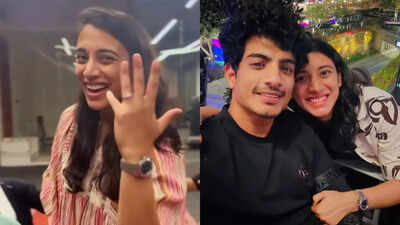
Smriti Mandhana was set to marry her longtime friend Palash Muchhal this week. Instead, the family postponed the ceremony after her father was suddenly hospitalised with heart-attack like symptoms, followed by reports that Muchhal himself was admitted to a hospital in Sangli due to emotional stress.The news has placed an unexpected pause in what was meant to be a personal milestone. It has also prompted a return to the longer story of how Mandhana built one of the most significant careers in Indian sport, shaped by early discipline, steady academic choices and years of incremental progress.
Early life and education in Sangli
Smriti Mandhana was born in Mumbai in July 1996, but her formative years unfolded in Madhavnagar in Sangli. Her schooling took place in local institutions, followed by her college education at Chintaman Rao College of Commerce.Her father and brother had both played cricket locally. Watching her brother compete in state-level tournaments shaped her early interests, and cricket entered her life through observation long before she realised it could become work.By the age of nine she was selected for Maharashtra’s under-15 team. At eleven she moved into Maharashtra’s under-19 set-up. Her early rise did not come from elite academies or specialist programmes.
It came from repetition, local coaching and a willingness to train before and after school hours.
Breaking through at a young age
Mandhana’s academic years overlapped with her first major cricketing milestone. At sixteen, she scored an unbeaten 224 in a domestic under-19 match, becoming the first Indian woman to score a double hundred in a List A game.This was the moment selectors and analysts began seeing her as more than a promising junior. For a teenager from Sangli, it was an early signal that her path would not follow the usual order of education first and sport later.
Her education and cricket career would instead develop in parallel.
Steady ascent into international cricket
Mandhana made her Women’s One Day (WODI) and Women’s Twenty20 (WT20I) debuts for India in 2013. She was seventeen. Her test debut followed in 2014, where she scored 22 and 51 against England.During India’s tour of Australia in 2016, she scored her first international century. Later that year, she was named in the Cricket Council’s Women’s Team of the Year.These years were marked by one consistent theme. She kept adding new formats, new leagues and new roles, even as she completed her academic commitments quietly in the background.
Learning through setbacks and recovery
In early 2017, Mandhana suffered an anterior cruciate ligament injury that kept her out for five months. For many young sportspersons, this is a period when academic backup plans become more significant.For Mandhana, the phase worked differently. The rehabilitation process sharpened her understanding of training, scheduling and long-term planning.
When she returned for the 2017 Women’s Cricket World Cup, she began the tournament with a player of the match performance and a century in the group stage.Her recovery, more than her runs, reshaped how she approached high-performance sport.
Building a career across leagues and formats
From 2016 onwards, Mandhana’s domestic and global career expanded rapidly. She played in the Australian Women’s Big Bash League, The Hundred, the Women’s Cricket Super League and later led the Royal Challengers Bengaluru to a Women’s Premier League title.She became the first Indian woman to score a century in all three formats of international cricket. She also became the fastest Indian cricketer to score 4,000 Women’s One Day runs and holds the record for the fastest century in One Day s by any Indian batter.Her educational path may not follow the usual template, but her career trajectory reads like a long case study in skill building, consistency and adaptation.
Leadership, records and the World Cup win
By her mid-twenties, Mandhana had already won ICC awards, captained India in Twenty20 s and collected honours that most players hope to earn late in their careers.In 2025, she played a central role as vice-captain when India won the ICC Women’s Cricket World Cup for the first time. During the tournament, she scored her 14th Women’s One Day century, drawing level with Meg Lanning for the most centuries in international cricket.These milestones are part of her professional story. Yet behind each milestone is the continuous work that began in a Sangli schoolground.
Why her path matters for students and young athletes
Mandhana’s journey is not only a sporting timeline. It is also an education and career lesson. Young athletes often believe they must choose between academics and sport, but Mandhana’s story shows a different pattern. Her rise is a sign of talent being important, but practice, and a structured routine often decide who eventually reaches the highest level.
A career still unfolding
The recent controversies have shifted public attention towards her personal life. Yet her professional legacy continues to grow. With more than 9,500 international runs, leadership roles across teams and global recognition, her career is still in motion.Her path from a Sangli schoolgirl to the face of Indian women’s cricket is not the story of one breakthrough moment. It is the story of years of training, early exposure, resilience and a clear understanding of what she wanted her career to become.

 1 hour ago
1 hour ago














